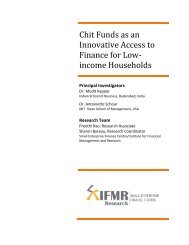Government of India Volume I: Analysis and Recommendations
Government of India Volume I: Analysis and Recommendations
Government of India Volume I: Analysis and Recommendations
Create successful ePaper yourself
Turn your PDF publications into a flip-book with our unique Google optimized e-Paper software.
FUNCTIONS AND POWERS OF THE REGULATOR<br />
Table <strong>of</strong> <strong>Recommendations</strong> 4.13 Requirement <strong>of</strong> administrative law <strong>of</strong>ficers<br />
The system <strong>of</strong> administrative law functions requires:<br />
◮ The board <strong>of</strong> the regulator will appoint one <strong>of</strong> its member as administrative law member;<br />
◮ The creation <strong>of</strong> a special class <strong>of</strong> <strong>of</strong>ficers called administrative law <strong>of</strong>ficers; <strong>and</strong><br />
◮ While serving as administrative law <strong>of</strong>ficers, these persons shall not carry out other functions. This is necessary<br />
to maintain separation <strong>of</strong> their roles <strong>and</strong> responsibilities from the other staff members <strong>of</strong> the regulator.<br />
Table <strong>of</strong> <strong>Recommendations</strong> 4.14 Judicial review <strong>of</strong> executive actions<br />
The Commission recommends the following principles for application <strong>of</strong> administrative law by the regulator:<br />
1. All investigations <strong>and</strong> internal processes should strictly conform to procedures <strong>of</strong> fairness;<br />
2. Even minor non-compliance to procedure should be required to be adequately explained by the regulator;<br />
3. Administrative law <strong>of</strong>ficers should act as disinterested third parties in a dispute; <strong>and</strong><br />
4. The decisions <strong>of</strong> administrative law <strong>of</strong>ficers will lead to the development <strong>of</strong> a body <strong>of</strong> cases similar to common<br />
law jurisprudence.<br />
Table <strong>of</strong> <strong>Recommendations</strong> 4.15 Procedure for administrative law functions<br />
1. All decisions to impose penalty or decisions requiring any action against any regulated entity should be carried<br />
out by administrative law <strong>of</strong>ficers;<br />
2. Administrative law <strong>of</strong>ficers should place the proposed decision <strong>of</strong> the executive <strong>and</strong> the material on which<br />
the decision was arrived at, before the regulated entity through a notice called a warning notice;<br />
3. The regulated entity must be allowed to respond before a decision is taken;<br />
4. The decision <strong>of</strong> the administrative <strong>of</strong>fice must be a reasoned decision <strong>and</strong> should be provided to the regulated<br />
entity or other concerned person through a notice called the decision notice; <strong>and</strong><br />
5. The regulated entity may ask the administrative law member <strong>of</strong> the board to review the decision taken by the<br />
administrative law <strong>of</strong>ficer.<br />
as an administrative law member. Under the member, the regulator will maintain a class<br />
<strong>of</strong> administrative law <strong>of</strong>ficers. The administrative law member will be responsible for<br />
oversight <strong>of</strong> the functioning <strong>of</strong> the administrative law <strong>of</strong>ficers. Consequently, such member<br />
will not take active part in executive functions <strong>of</strong> the regulator <strong>and</strong> not be involved in<br />
any investigation, inspection or similar other functions.<br />
Like the administrative law members, the administrative law <strong>of</strong>ficers will also not be<br />
involved in any investigation proceedings. This would, however, be achieved without<br />
creating a wall <strong>of</strong> separation within the regulator – administrative law <strong>of</strong>ficers would be<br />
drawn from the general pool <strong>of</strong> employees <strong>of</strong> the regulator but as long as such persons are<br />
involved in judicial functions they would not be involved in any other regulatory functions<br />
(see Table 4.13).<br />
4.3.2. Procedure for administrative law functions<br />
The administrative law functions <strong>of</strong> the regulator are at two levels. The first level adjudication<br />
will be done by administrative law <strong>of</strong>ficers who will work inside the agency <strong>of</strong> the<br />
regulator but will not be involved in executive functions. While exercising their functions,<br />
the administrative law <strong>of</strong>ficers will examine the data <strong>and</strong> evidence collected by the regulator’s<br />
executive <strong>of</strong>ficers <strong>and</strong> will assess the appropriateness <strong>of</strong> their executive orders (see<br />
Table 4.14).<br />
Appeals from the orders <strong>of</strong> the administrative law <strong>of</strong>ficers will go to the administrative<br />
law members <strong>of</strong> the board. This process will act as a performance review <strong>of</strong> the administrative<br />
law <strong>of</strong>ficers <strong>and</strong> also reduce the number <strong>of</strong> appeals to the tribunal by weeding<br />
out flawed orders. Table 4.15 summarises the administrative law related processes <strong>of</strong> the<br />
regulator.<br />
38 FINANCIAL SECTOR LEGISLATIVE REFORMS COMMISSION



